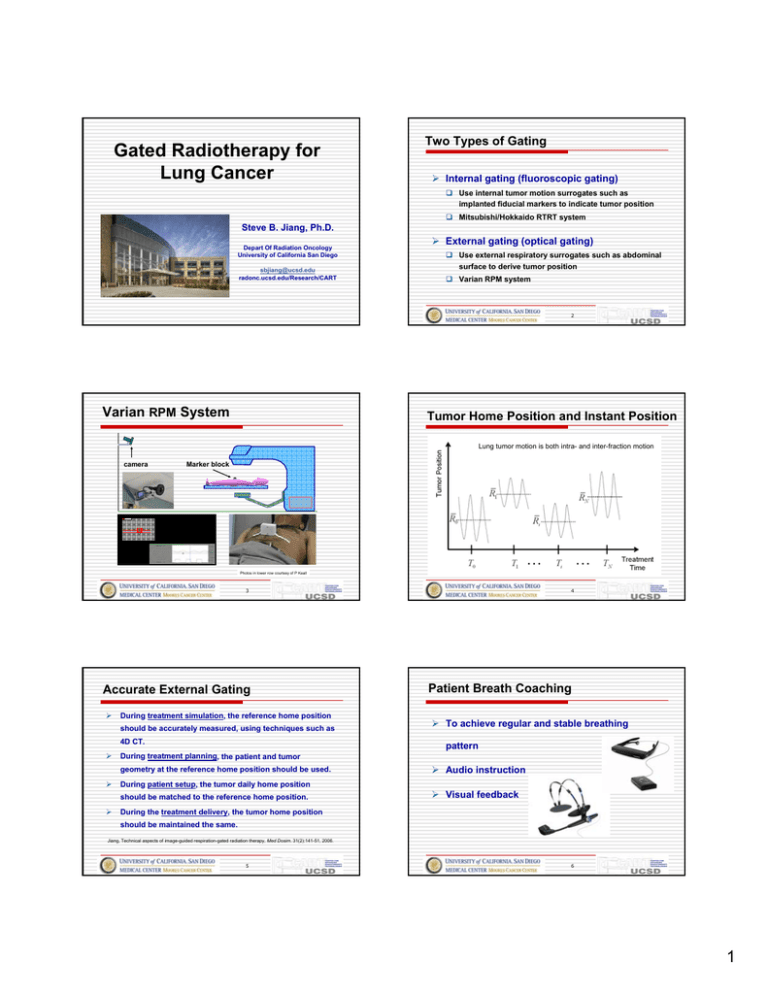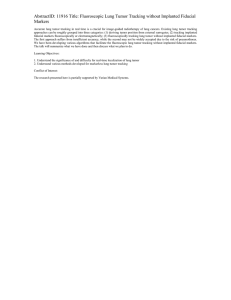Gated Radiotherapy for Lung Cancer Two Types of Gating
advertisement

Gated Radiotherapy for Lung Cancer Two Types of Gating ¾ Internal gating (fluoroscopic gating) Use internal tumor motion surrogates such as implanted fiducial markers to indicate tumor position Mitsubishi/Hokkaido RTRT system Steve B. Jiang, Ph.D. Depart Of Radiation Oncology University of California San Diego sbjiang@ucsd.edu radonc.ucsd.edu/Research/CART ¾ External gating (optical gating) Use external respiratory surrogates such as abdominal surface to derive tumor position Varian RPM system 2 Varian RPM System Tumor Home Position and Instant Position Lung tumor motion is both intra- and inter-fraction motion camera Marker block Photos in lower row courtesy of P Keall 3 Accurate External Gating ¾ During treatment simulation, the reference home position should be accurately measured, using techniques such as 4D CT. ¾ ¾ To achieve regular and stable breathing pattern ¾ Audio instruction During patient setup, the tumor daily home position should be matched to the reference home position. ¾ Patient Breath Coaching During treatment planning, the patient and tumor geometry at the reference home position should be used. ¾ 4 ¾ Visual feedback During the treatment delivery, the tumor home position should be maintained the same. Jiang, Technical aspects of image-guided respiration-gated radiation therapy, Med Dosim. 31(2):141-51, 2006. 5 6 1 A Breath Coaching Protocol Moving Objects during CT – A Phantom Study Free breathing Coached breathing Video courtesy of George T.Y. Chen Neicu, Berbeco, Wolfgang, and Jiang, Phys Med Biol. 51(3):617-636, 2006. Chen, Kung, and Beaudette, Semin Radiat Oncol. 14(1):19-26, 2004. Patient 5618 7 8 CT Simulation for Gated Lung Cancer RT Motion Artifacts ¾ Breath-hold CT scan Voluntary breath hold Active breathing control ¾ Slow CT san 4 seconds per slice in axial mode ¾ 4D CT scan 3D scans at multiple phases Photo Static Moving / HS mode HQ Courtesy of George Chen 9 10 Patient Setup for Gated Lung Cancer RT 4DCT Scan of A Phantom ¾ Room laser/skin tattoos ¾ X-ray image of bony structure ¾ 3D/4D cone beam CT Courtesy of Eike Rietzel and George T.Y. Chen 11 12 2 Patient Setup For Gated Lung Cancer RT ¾ Patient Setup For Gated Lung Cancer RT ¾ Room laser/skin tattoos X-ray images of bony structure Nelson, Starkschall, Balter, Morice, Stevens, Chang, Int J Radiat Oncol Biol Phys, 67(3):915-23, 2007. 13 Inter- and Intra-fraction Motion of Lung Tumor Courtesy of Lei Dong 14 Patient Setup For Gated Lung Cancer RT M van Herk, L Zijp, P Remeijer, J Wolthaus, JJ Sonke, ICCR 2007. 15 On-line Treatment Verification 16 Cine EPID for Lung Tx Verification using ANN ¾ Before treatment ¾ Based on MV imager Generate simulated EPID images using CT data for each beam and with various possible positional errors Train ANN using the simulated EPID images to recognize two classes: tumor within/without the beam aperture ¾ During treatment ¾ Based on kV imager Apply the trained network to cine EPID images to see if the tumor is inside the beam ¾ Preliminary results 6 patients, 4-5 fractions each 95% accuracy TH-D-AUD C-9 Thursday 12:30:00 PM - 2:20:00 PM Room: Aud-C 17 18 3 Mitsubishi/Hokkaido RTRT System Mitsubishi/Hokkaido RTRT System (Screen Capture) ¾ 4 sets diagnostic X-ray systems Image Intensifier ¾ Motion tracking software ¾ Carbon fiber couch ¾ 2 mm gold marker inside/near tumor ¾ 1 mm detection accuracy ¾ 0.033 s time delay X-ray Tube Video courtesy of H Shirato Shirato et al IJROBP 48:435-442, 2000 19 20 Implantation of Fiducial Markers Multiple Hypothesis Tracking 18G x 150 m m depth ark depth m m ark baseof ofneedl needlee base CT guided implantation Varian Trilogy Elekta Synergy Siemens Artiste 0. 86~0. m m 8φm m φ 0. m andril 31.5~3 mm mm MGH IRIS Tang, Sharp, and Jiang, Phys Med Biol, 52:4081-4098, 2007 US guided implantation 21 Lung Tumor Tracking without Markers 22 Direct Tracking of Lung Tumor Mass ¾ Multiple Template Tracking Cui, Dy, Sharp, Alexander, and Jiang Phys Med Biol, 52(20):6229-6242, 2007. ¾ Active Shape Model Tracking Xu, Hamilton, Schowengerdt, and Jiang Phys Med Biol, 52(17):5277-5293, 2007. ¾ Optical Flow Tracking Xu, Hamilton, Schowengerdt, Alexander, and Jiang Med Phys, 2008 (in print) 23 24 4 Indirect Fluoroscopic Tracking Algorithm for Indirect Tracking (1) ¾ Issues with direct tracking ¾ Choose surrogate ROIs Directly tracking of the tumor sometimes is impossible due to poor image quality and low target contrast Common tracking methods used in computer vision often fails since tumor has no color, no texture, and often no clear shape ¾ Red tumor position We proposed an indirect tracking approach Green Tracking invisible tumor by tracking visible surrogate features two ROIs 25 Algorithm for Indirect Tracking (2) ¾ Map each ROI frame into 3D PCA space Each ROI frame is represented as (x1, x2, x3) 26 Algorithm for Indirect Tracking (3) ¾ Pre-treatment training Regression between tumor location (y1, y2) and the 3D PCA coordinates of each ROI ¾ During treatment Prediction based on the regression 27 Indirect Fluoroscopic Tracking 28 Indirect Lung Tumor Tracking ¾ Machine learning techniques PCA for dimensionality reduction and feature extraction Regression (1-degree, 2-degree, ANN, SVM) ¾ Experiments Fluoroscopic sequences of 10 lung cancer patients Mean tracking error: ~1.1 mm Maximum error at 95% confidence level: 2.3 mm TU-C-351-9 Tuesday 10:00:00 AM - 12:00:00 PM Room: 351 Lin and Jiang, Fluoroscopic lung tumor tracking, 2008 (to be submitted) 29 Lin, Cervino, Tang, Vasconcelos, and Jiang, Fluoroscopic Tumor Tracking for Image Guided Lung Cancer Radiotherapy, Phys Med Biol 2008 (submitted) 30 5 Gating as A Template Matching Problem Gating as A Classification Problem Training: Training Fluoroscopic Images Treatment: Incoming Fluoroscopic Images Preprocessing (PCA, etc) Template Building Reference Template(s) Training: Training Fluoroscopic Images Treatment: Incoming Fluoroscopic Images ¾ Template Matching & Scoring Preprocessing (PCA, etc) Gating Signal Trained Classifier Labeling Preprocessing (PCA, etc) Classification Gating Signal Classification methods tested Support Vector Machines (SVM) Artificial Neural Network (ANN) ⎯ Berbeco, Mostafavi, Sharp, and Jiang, Phys Med Biol. 50(19): 4481-4490, 2005. Preprocessing (PCA, etc) ⎯ Cui, Dy, Alexander, and Jiang, Phys Med Biol. 2008 (in print) Lin, Tang, Dy, and Jiang, Phys Med Biol. 2008 (submitted) Cui, Dy, Sharp, Alexander, Jiang, Phys Med Biol. 52(3):741-55, 2007. 31 ANN based Gating 32 Pros and Cons of Each Gating Method ¾ Internal: accurate however expensive Carefully implanted multiple fiducial markers High cost, invasive, imaging dose ¾ External: less expensive however less accurate Low cost, noninvasive, radiation free, easy to implement Uncertainties in external/internal correlation 33 34 Combine External/Internal Signals Future Gated Lung Cancer RT ¾ Hybrid gating ¾ Drive tumor positions from external surrogates ¾ Low frequency updating of external/internal correlation ¾ Respiratory surrogates → gating signals Better respiratory signals Real-time 3D surface imaging X-ray images → update internal/external correlation Only taken when necessary Derive tumor positions using machine learning methods Correlation based on sophisticated lung models Breath coaching ¾ Cine EPID based on-line treatment verification ¾ Very high dose rate 35 Required for some patients to ensure sufficient accuracy and efficiency “Snapshot” therapy 36 6 Future Gated Lung Cancer RT ¾ Gating should be applied to every lung cancer RT ¾ Nothing to lose when motion is small ~ 100% duty cycle ¾ Motion may change later in the treatment course Which of the following CT simulation technique is best suited for gated treatment of lung cancer patients? 1. 4D CT scan 2. Breath hold CT scan 3. Slow CT scan 0% 4. Free breathing CT scan 0% 5. None of the above 0% 0% 0% ¾ Gating can be used to monitor patient motion 37 38 10 Which of the following statement is NOT true for gating based on external surrogates (external gating)? Answer: 1 – 4D CT scan 0% References 0% Jiang SB Radiotherapy of mobile tumors Semin Radiat Oncol, 2006. 16(4): p. 239-48. Jiang SB Technical aspects of image-guided respiration-gated radiation therapy Med Dosim, 2006. 31(2): p. 141-51. 1. External gating is non-invasive 2. External gating is relatively easy to implement 3. External gating does not require any radiation dose for imaging 4. External gating reply on a good and stable correlation between tumor motion and surrogate signal 5. The correlation between tumor motion and surrogate signal does not change intra- and inter-fractionally for any lung cancer patients 0% 0% 0% 39 Answer: 5 – The correlation between tumor motion and surrogate signal does not change intra- and interfractionally for any lung cancer patients 40 Which of the following statement is NOT true for gating based on implanted fiducial markers (internal gating)? 0% References 0% Jiang SB Radiotherapy of mobile tumors Semin Radiat Oncol, 2006. 16(4): p. 239-48. Jiang SB Technical aspects of image-guided respiration-gated radiation therapy Med Dosim, 2006. 31(2): p. 141-51. 41 10 1. Internal gating is less accurate than external gating 2. Internal gating is more invasive than external gating 3. Marker implantation in lung may cause pneumothorax 4. High imaging dose may be required for the fluoroscopic tracking of the implanted fiducial markers 5. The combination of external and internal gating may reduce the imaging dose 0% 0% 0% 42 10 7 Answer: 1 – Internal gating is less accurate than external gating Acknowledgement References Jiang SB Radiotherapy of mobile tumors Semin Radiat Oncol, 2006. 16(4): p. 239-48. Jiang SB Technical aspects of image-guided respiration-gated radiation therapy Med Dosim, 2006. 31(2): p. 141-51. 43 44 8





